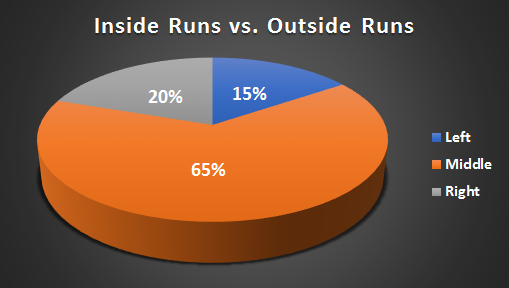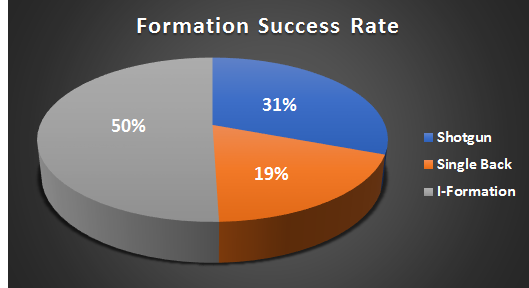Devy Profile: Nick Chubb, RB Georgia
Nick Chubb was on top of the world as one of the top running back prospects in the nation before he blew his knee out during his sophomore season. Since then, his stock in devy leagues decreased to the point where he’s no longer considered as the top back in the nation. As we all know, the current debate for the top spot is between Saquon Barkley and Derrius Guice.
Can Chubb catapult himself back to the top of the running back ranks with a solid senior season or is he destined to finish his career ranked just below of some of the top backs in his draft class? There are a lot of factors that come into play when it comes to predicting his potential output for the 2017 season, but one thing we all can agree on is that he’s a very talented running back who could become a stud once he hits the NFL.
As a Recruit
Chubb went to school at Cedar Town High School, located about an hour west of Atlanta Georgia. He led the state in rushing during his junior season with 2,721 yards and 38 touchdowns, and was also very dynamic during his senior season with 2,690 yards and 41 touchdowns, leading his team to a 9-2 record that year. He was also a stellar track and field athlete where he was a standout at the 100 and 200-meter dash, the shot put and the long jump.
247Sports ranked him the fifth best running back in his recruiting class behind Leonard Fournette, Dalvin Cook, Sony Michel and Roc Thomas. He was a five-star prospect who drew interest from a lot of the top collegiate programs like Alabama, Ohio State, Florida State, Penn State, Florida, Auburn, Notre Dame and Miami.
He participated in the 2013 Nike SPARQ Combine where measured in at 5’11’’ while weighing 217-pounds. Chubb displayed his speed at the combine by running a 4.47 40-yard dash. He also received the opportunity to showcase his talents in the U.S. Army All-American Bowl, a feat that not many high school football players ever get to experience.
[am4show have=’g1;’ guest_error=’sub_message’ user_error=’sub_message’ ]
Freshman Season
As a true freshman in 2014, Chubb started his first game in week six when he rushed for 143 yards and one touchdown while catching four passes for 31 yards against the Missouri Tigers. From there he reeled off eight straight performances with at least 100 yards rushing and his best game was in the Belk Bowl when he rushed for 266 yards and two touchdowns. Even though he was a just a freshman and began his season as the team’s backup during the first five weeks of the season, he still managed to own a 29.57 percent market share of the team’s total offensive production.
Sophomore Season
Chubb started six games during his sophomore season, rushing for 747 yards and seven touchdowns while catching four passes for 32 yards and one touchdown. He rushed for 120-yards or more in five straight games while owning a 34.61 percent market share of the team’s offensive production during those five games.
Chubb suffered a horrific injury playing against Tennessee during week six, tearing multiple ligaments in his left knee, including his PCL. Due to the severity of the injury, a lot of devy and dynasty enthusiasts carried a lot of doubt concerning Chubb’s potential long-term player value in fantasy football.
Junior Season
He successfully rehabbed his knee to appear in all 13 games, rushing for 1,130 yards and eight touchdowns. Chubb eclipsed the 100-yard mark five times last year and his best game was against North Carolina during the season opener when he rushed for 222 yards and two touchdowns. Even though he shared carries out of the backfield with Sony Michel he still managed to own a 24.32 percent market share of the team’s offensive production.
He’s currently second behind Herschel Walker with 3,424 career rushing yards for the University of Georgia. He also has 19 100-yard games over the course of his career and nine games with multiple rushing touchdowns.
Running Style
Chubb’s tape stands out compared to most running backs, mainly due to his burst to and through the hole and his ability to decipher the defense and quickly find the running lane. Defenses must be on their toes when he’s in the backfield, because in a moment’s notice, he can be in the second level of the defense ready to rip off a long gain. He’s dangerous in the open field and his ability to pick up yards in bunches puts fear in the back of the minds of defensive backs and linebackers.
Mass times acceleration equals force, and Chubb’s elite level burst paired with his 228-pound frame allows him to deliver a lot of power at the point of contact, causing him to drive back defenders and easily break through arm tackles. He has the acceleration and speed of a smaller back but the power of a short yardage and goal line back.
His ability to use his footwork to make crisp cuts while maintaining his balance after contact is second to none. He can cut on a dime and is very efficient at reading his blockers to cut laterally away from tacklers. Chubb does everything with speed while maintaining balance, making him very slippery in the open field. He must be a good dancer because he never gets tripped up while approaching the line of scrimmage.

The chart above is derived from a ten-game sample, equating to a total of 212 carries.
As the chart dictates, 65 percent of Chubb’s carries are directed between the tackles, indicating that the team relies on him to grind out the tough yards up the middle of the defense. Also, the offensive line does a tremendous job at creating rushing lanes through both the A and B gaps. This allows Chubb to easily read the defense and make his move off the offensive line’s initial engagement with the opposing defensive line. The distribution between outside runs and inside runs are adequate, providing the depiction that he doesn’t rely on outside runs to gain most of his yardage.

The statistics in the chart above reflect how many times he lined up in the listed formations. The data is derived from a ten-game sample.
The Georgia Bulldogs do a pretty good job at using Chubb in different formations. His usage is almost evenly distributed between shotgun, single back and I-formation (two back) sets. The variety of formations that are utilized speaks to diversity of Chubb’s game as he’s capable of being reliable in any formation.

The statistics in the chart above display his success rate (plays of four yards or more) in the listed formations. The percentages in the chart are derived from a ten-game sample with a total of 101 carries with four yards or more.
Chubb does his best work out of the I-formation, because he does a really good job at reading his lead blocker, allowing him to quickly make his move to the open rushing lane. The defense is usually spread-out while he’s operating out of the shotgun formation and at times will allow for the running lanes to be much larger than what they normally would. Without the lead blocker on rush attempts out of single back formation, sometimes the offense line would get beat by the defense, generating zero yardage gained for Chubb. However, He still was more than capable of breaking long runs as the lone back in the formation.
Passing Game
He’s a willing blocker and is not afraid to get down and dirty with blitzing defensive linemen. Sometimes he will get caught out of position and will entirely miss the incoming defender. Whiffed blocks are few and far between, but they will happen from time to time. This is normal for most running back prospects as it takes a few years for a running back to fully grasp the finer nuances of picking up the blitz.
Chubb’s ability to eat up yards in the open field makes him a very dangerous receiving threat out of the backfield. Once he catches the ball, he’s a threat to score from anywhere on the field and is almost impossible for smaller defensive backs to tackle in one-on-one situations. Most of his receptions are from out routes, check downs and screens out of the backfield. Like most running backs, He’s not asked to run a large variety of routes. His hands are strong and he’s very good at out muscling defenders at the catch point.
2014 Chubb vs. 2016 Chubb
Before the knee injury, Chubb was about as explosive as a human being could possibly get and he was very decisive before making his initial move toward the line of scrimmage. During his comeback in 2016, it was quite apparent that he lost some of the twitch in his step and at times was a little bit hesitant before making some of his decisions. Expect him to have a little bit more pop in his step in 2017 as he’s farther removed from the knee surgery. It takes time for some players to regain their speed, burst and overall confidence from a serious injury.
Conclusion
Chubb is one of the best backs in the nation and should be one of the top assets in most devy leagues. His injury in 2015 was unfortunate, but he should eventually be able to return to his old form. This might be the last time you will be able to buy his stock at its current price, because if he dominates this year like he did during his freshman season, then his price tag will go through the roof.
With a solid performance in 2017, there’s a chance that he could emerge as the top back in next year’s draft class, supplanting both Derrius Guice and Saquon Barkley. For that to happen, he must first return to his old form and take over the SEC in dominating fashion like he did a few years ago.
[/am4show]


































































